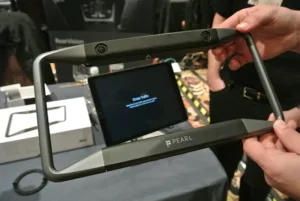 In the final presentation at the Consumer Telematics Conferance, held at the out-of-the-way Rio Hotel and Casino in Las Vegas on January 4 (the day before the CES exhibits opened), Roger Lanctot of Strategy Analytics predicted the return of the automotive aftermarket.
In the final presentation at the Consumer Telematics Conferance, held at the out-of-the-way Rio Hotel and Casino in Las Vegas on January 4 (the day before the CES exhibits opened), Roger Lanctot of Strategy Analytics predicted the return of the automotive aftermarket.
Of course the accessories aftermarket — the market for electronic, mechanical, and decorative accessories that are purchased by a vehicle’s owner after he buys the vechicle — never died. In fact, it’s growing, according to the Add-On Auto 2015 Auto Accessories Annual Trend Report. But only one of the top 10 accessory categories –alarms, remote starters, and recovery — incorporates electronics. Among the other top-10 categories by volume are high-tech items such as floor mats, window tints, and roof racks.
Lanctot, it quickly became clear, was asking if there is a business model for a safety aftermarket, and he logically concluded there is.
As if to support Lanctot’s conclusion, even at this relatively early stage of the category’s development, a number of companies were showing radar detectors, collision cameras, and navigation devices, including those designed to work off-road. We did not see any aftermarket blind-spot detectors at CES, but they exist.
Here are a few of the more novel aftermarket items we saw.
Escort showed it’s new custom-installed radar detector, which it calls “the world’s most advanced detection system.” Customers who pay approximately $3000 for the system probably expect that claim to be true. The system comprises a display module, a control module, an interface box, a GPS antenna, a front radar receiver, a laser shifter bridge box, two front laser receivers/shifters, and amplified speaker, and a hidden bi-color display — a red/green status light that is mounted within the instrument cluster. Escort has other custom-installed detection systems. This new one becomes the top of the line.
Back-up cameras are relatively inexpensive and so effective in preventing minor collisions and, more importantly, backing over children (a surprisingly common occurrence), that the the U.S. NHTSA is mandating them in all new cars starting in May 2018. The cost-benefit of adding these devices to older cars is clear, but the typical system — and there are many — requires mounting the camera and the display, wiring them power sources, and routing a cable from the camera head to the display. That’s enough complexity to deter many would-be purchasers.
At the CES Unveiled press and analyst event, Look-It introduced is “drive HD” wireless back-up cam that is completely wireless. The camera head is integrated into a license-plate frame and operates on an included battery with a four-year lifetime, according to Look-It. The camera communicates wireless with the driver’s mobile phone, which can be mounted to a dash vent or the windshield using one of many available phone mounts. A wireless on/off switch mounts to the dash or the steering-wheel rim. Press it and the drive-HD app on the phone is activated and you are seeing what’s behind you.
At Pepcom’s Digital Experience — another press-and-analyst event — start-up Pearl Automation showed a more sophisticated wireless license-plate rear-vision system at an MSRP of about $500, twice the price of the ‘drive HD’. Pearl, which was founded by three Apple alumni, incorporates a solar array to keep its battery charged, and has two camera heads, one sensitive in the infrared for enhanced night-time visibility, and one optimized for daylight. Each, says Pearl, has a seven-element lens with up to a 180-degree field of view. The cameras can be panned left and to detect objects over a much greater angle.
Pearl uses a car adaptor that plugs into the OBD port. The adaptor contains an eight-core processor that analyzes images from both cameras when the car is being driven in reverse. Wireless communication is via WiFi and Bluetooth, Pearl says, but it was not clear whether that as true for both the camera-to-adaptor link and the adaptor-to-phone link.
When an obstacle is detected, a speaker in the adaptor sounds a tone and the object is highlighted in the Pearl app. Like drive HD, Pearl uses the user’s mobile phone for its display and to run its app, but it seems that drive HD is a rear-view camera only, while Pearl also embodies a warning system. Pearl includes a phone mount of its own design.
Both of these systems, with different levels of functionality and, consequently, different price points qualify as intelligently conceived new products in Lanctot’s safety aftermarket. — KIW
Pearl Automation’s dual, panning back-up cameras are embedded in a license-plate frame, which also includes a rechargeable battery, solar array, and wireless transmitter. (Photo: Ken Werner)

